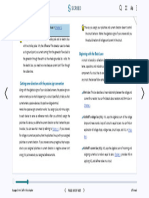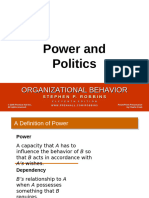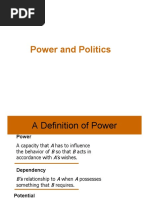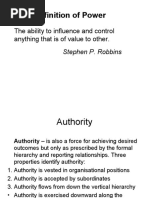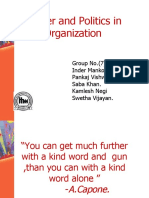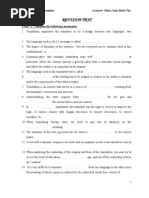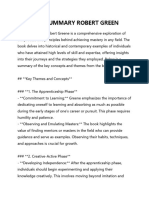Ch14 Power Politics
Ch14 Power Politics
Uploaded by
Khoirunissa Azizah NugrahaCopyright:
Available Formats
Ch14 Power Politics
Ch14 Power Politics
Uploaded by
Khoirunissa Azizah NugrahaCopyright
Available Formats
Share this document
Did you find this document useful?
Is this content inappropriate?
Copyright:
Available Formats
Ch14 Power Politics
Ch14 Power Politics
Uploaded by
Khoirunissa Azizah NugrahaCopyright:
Available Formats
Chapter FOURTEEN
Power and Politics
© 2007 Prentice Hall Inc. All rights reserved.
A Definition of Power
Power
A capacity that A has to influence
the behavior of B so that B acts in
accordance with A’s wishes.
Dependency
B’s relationship to A when
A possesses something
that B requires.
© 2007 Prentice Hall Inc. All rights reserved.
Contrasting Leadership and Power
Leadership Power
– Focuses on goal – Used as a means for
achievement. achieving goals.
– Requires goal – Requires follower
compatibility with dependency.
followers. – Used to gain lateral
– Focuses influence and upward
downward. influence.
Research Focus Research Focus
– Leadership styles – Power tactics for
and relationships gaining compliance.
with followers.
© 2007 Prentice Hall Inc. All rights reserved.
Bases of Power: Formal Power
Formal Power
Is established by an individual’s position in an
organization; conveys the ability to coerce or
reward, from formal authority, or from control of
information.
Coercive Power
A power base dependent on fear.
Reward Power
Compliance achieved based on
the ability to distribute rewards
that others view as valuable.
© 2007 Prentice Hall Inc. All rights reserved.
Bases of Power: Formal Power (cont’d)
Legitimate Power
The power a person receives as a result
of his or her position in the formal
hierarchy of an organization.
© 2007 Prentice Hall Inc. All rights reserved.
Bases of Power: Personal Power
Expert Power
Influence based on special
skills or knowledge.
Referent Power
Influence based on possession
by an individual of desirable
resources or personal traits.
© 2007 Prentice Hall Inc. All rights reserved.
Source: Drawing by Leo Cullum in The New Yorker, copyright ©1986 E X H I B I T 14–1
The New Yorker Magazine. Reprinted by permission.
© 2007 Prentice Hall Inc. All rights reserved.
Dependency: The Key To Power
The General Dependency Postulate
– The greater B’s dependency on A, the greater the
power A has over B.
– Possession/control of scarce organizational resources
that others need makes a manager powerful.
– Access to optional resources (e.g., multiple suppliers)
reduces the resource holder’s power.
What Creates Dependency
– Importance of the resource to the organization
– Scarcity of the resource
– Nonsubstitutability of the resource
© 2007 Prentice Hall Inc. All rights reserved.
Power Tactics
Power Tactics
Influence Tactics:
Ways in which • Legitimacy
individuals translate
• Rational persuasion
power bases into
specific actions. • Inspirational appeals
• Consultation
• Exchange
• Personal appeals
• Ingratiation
• Pressure
• Coalitions
© 2007 Prentice Hall Inc. All rights reserved.
Preferred Power Tactics by Influence Direction
Upward Influence Downward Influence Lateral Influence
Rational persuasion Rational persuasion Rational persuasion
Inspirational appeals Consultation
Pressure Ingratiation
Consultation Exchange
Ingratiation Legitimacy
Exchange Personal appeals
Legitimacy Coalitions
E X H I B I T 14–2
© 2007 Prentice Hall Inc. All rights reserved.
Factors Influencing the Choice and
Effectiveness of Power Tactics
Sequencing of tactics How the request is
– Softer to harder tactics perceived
work best. – Is the request consistent
Skillful use of a tactic with the target’s values?
Relative power of the The culture of the
tactic user organization
– Some tactics work better – Culture affects user’s
when applied downward choice of tactic.
or upward. Country-specific cultural
The type of request factors
attaching to the tactic – Local values favor certain
– Is the request legitimate? tactics over others.
© 2007 Prentice Hall Inc. All rights reserved.
Power in Groups: Coalitions
Coalitions
• Seek to maximize their
Clusters of individuals size to attain influence.
who temporarily come • Seek a broad and diverse
together to achieve a constituency for support
specific purpose. of their objectives.
• Occur more frequently in
organizations with high
task and resource
interdependencies.
• Occur more frequently if
tasks are standardized
and routine.
© 2007 Prentice Hall Inc. All rights reserved.
Sexual Harassment: Unequal Power in the
Workplace
Sexual Harassment
– Unwelcome advances, requests for sexual favors, and
other verbal or physical conduct of a sexual nature.
The U.S. Supreme Court test for determining if
sexual harassment has occurred:
– Whether comments or behavior
in a work environment
“would reasonably be
perceived, and is
perceived, as hostile
or abusive.”
© 2007 Prentice Hall Inc. All rights reserved.
Steps for Managers to Take to Prevent Sexual
Harassment
Make sure a policy against it is in place.
Ensure that employees will not encounter
retaliation if they file a complaint.
Investigate every complaint and include
the human resource and legal
departments.
Make sure offenders are disciplined or
terminated.
Set up in-house seminars and training.
© 2007 Prentice Hall Inc. All rights reserved.
Politics: Power in Action
Political Behavior
Activities that are not required as part of one’s
formal role in the organization, but that influence, or
attempt to influence, the distribution of advantages
or disadvantages within the organization.
Legitimate Political Behavior
Normal everyday politics.
Illegitimate Political Behavior
Extreme political behavior that violates the implied
rules of the game.
© 2007 Prentice Hall Inc. All rights reserved.
Politics Is in the Eye of the Beholder
“Political” Label “Effective Management” Label
1. Blaming others vs. Fixing responsibility
2. “Kissing up” vs. Developing working relationships
3. Apple polishing vs. Demonstrating loyalty
4. Passing the buck vs. Delegating authority
5. Covering your rear vs. Documenting decisions
6. Creating conflict vs. Encouraging change and innovation
7. Forming coalitions vs. Facilitating teamwork
8. Whistle blowing vs. Improving efficiency
9. Scheming vs. Planning ahead
10. Overachieving vs. Competent and capable
11. Ambitious vs. Career-minded Source: Based on T. C. Krell, M. E.
Mendenhall, and J. Sendry, “Doing
12. Opportunistic vs. Astute Research in the Conceptual Morass of
Organizational Politics,” paper
13. Cunning vs. Practical-minded presented at the Western Academy of
Management Conference, Hollywood,
14. Arrogant vs. Confident CA, April 1987.
15. Perfectionist vs. Attentive to detail E X H I B I T 13–3
© 2007 Prentice Hall Inc. All rights reserved.
Factors That Influence
Political Behaviors
E X H I B I T 14-4
© 2007 Prentice Hall Inc. All rights reserved.
Employee Responses to
Organizational Politics
E X H I B I T 14-5
© 2007 Prentice Hall Inc. All rights reserved.
Defensive
Avoiding Action: Behaviors
• Overconforming
• Buck passing
• Playing dumb Avoiding Blame:
• Stretching • Buffing
• Stalling • Playing safe
• Justifying
• Scapegoating
Avoiding Change:
• Misrepresenting
• Prevention
• Self-protection
E X H I B I T 14–6
© 2007 Prentice Hall Inc. All rights reserved.
Impression Management (IM)
Impression Management
The process by which IM Techniques:
individuals attempt to • Conformity
control the impression • Excuses
others form of them.
• Apologies
• Self-Promotion
• Flattery
• Favors
Source: Based on B. R. Schlenker, Impression Management (Monterey, CA:
Brooks/Cole, 1980); W. L. Gardner and M. J. Martinko, “Impression • Association
Management in Organizations,” Journal of Management, June 1988, p. 332;
and R. B. Cialdini, “Indirect Tactics of Image Management Beyond Basking,”
in R. A. Giacalone and P. Rosenfeld (eds.), Impression Management in the
Organization (Hillsdale, NJ: Lawrence Erlbaum Associates, 1989), pp. 45–
71.
E X H I B I T 14–7
© 2007 Prentice Hall Inc. All rights reserved.
Is A Political Action Ethical?
1. What is the utility of
engaging in the
behavior?
2. Does the utility
balance out any harm
done by the action?
3. Does the action
conform to standards
of equity and justice?
E X H I B I T 14–8
© 2007 Prentice Hall Inc. All rights reserved.
Chapter Check-Up: Power & Politics
Write down two differences
between power and leadership.
Discuss with a classmate.
Do all leaders have power? Does
everyone with power lead others?
Discuss.
© 2007 Prentice Hall Inc. All rights reserved.
Chapter Check-Up: Power & Politics
When you go to work, what three
things can you do to make people
in your organization dependent on
you? Write down your answers on
a sheet of paper.
Discuss your answers with your
neighbor. Do you think it’s bad to plan
how you’ll get power over others?
© 2007 Prentice Hall Inc. All rights reserved.
Chapter Check-Up: Power & Politics
What is the difference
between a power tactic
and an influence tactic?
Discuss with a neighbor.
© 2007 Prentice Hall Inc. All rights reserved.
You might also like
- Circuit Analysis For DummiesDocument1 pageCircuit Analysis For Dummiesserviceseasy3No ratings yet
- Operations Management Theory and Practice by B. MahadevanDocument865 pagesOperations Management Theory and Practice by B. MahadevanAshik Paul100% (5)
- Body - Control SystemDocument94 pagesBody - Control Systemscott glacken100% (1)
- Ob 12Document12 pagesOb 12Muhammad Tariq SharifNo ratings yet
- Lecture On Power and PoliticsDocument23 pagesLecture On Power and PoliticsTazinNo ratings yet
- Unit 10 - Power and PoliticsDocument22 pagesUnit 10 - Power and Politics8tkpsn2f8wNo ratings yet
- Power and Politics: FourteenDocument24 pagesPower and Politics: FourteenDaniel Porras ReyesNo ratings yet
- 8.power and Politics-1Document20 pages8.power and Politics-1abelNo ratings yet
- Power and Politic Teori Perilaku OrganisasiDocument24 pagesPower and Politic Teori Perilaku OrganisasiLatifah AmeliaNo ratings yet
- Power and Politics: Organizational BehaviorDocument16 pagesPower and Politics: Organizational BehaviorRanbir KapoorNo ratings yet
- Power Tactics PPT FinalDocument19 pagesPower Tactics PPT FinalClarissa PacatangNo ratings yet
- Organizational Behavior: Power and PoliticsDocument23 pagesOrganizational Behavior: Power and PoliticsDr-Rekha NNo ratings yet
- POWER and POLITICS PPT MBADocument25 pagesPOWER and POLITICS PPT MBApreethiramesh0611No ratings yet
- Power and Politics: Reporter: Aljohn G. MangudadatuDocument32 pagesPower and Politics: Reporter: Aljohn G. MangudadatuHasan AlidingNo ratings yet
- Power and PoliticsDocument85 pagesPower and PoliticsElizabeth HeartfeltNo ratings yet
- Organizational Behavior: Power and PoliticsDocument21 pagesOrganizational Behavior: Power and PoliticsMd. Mahmudul IslamNo ratings yet
- Chap13 - Organizational BehaviorDocument23 pagesChap13 - Organizational BehaviorKurt100% (1)
- Unit 3.5 Power and PoliticsDocument18 pagesUnit 3.5 Power and PoliticsMusom BBANo ratings yet
- Organizational Behavior: Power and PoliticsDocument23 pagesOrganizational Behavior: Power and PoliticsLâm LêNo ratings yet
- Power and PoliticsDocument85 pagesPower and PoliticsElizabeth HeartfeltNo ratings yet
- Power and Politics: Organizational BehaviorDocument12 pagesPower and Politics: Organizational Behavioryakan_aNo ratings yet
- Unit IvDocument6 pagesUnit IvKrishnamoorthy RamakrishnanNo ratings yet
- SM-VIII-Understanding Dynamics of Power and PoliticsDocument27 pagesSM-VIII-Understanding Dynamics of Power and Politicsbharat bhatNo ratings yet
- Organizational Behavior: Robbins & JudgeDocument22 pagesOrganizational Behavior: Robbins & JudgeRamashish Yadava0% (1)
- Chapter 13 - Power and PoliticsDocument29 pagesChapter 13 - Power and Politicsabhikag12No ratings yet
- Power N PoliticsDocument17 pagesPower N Politicsapurvaanjan60No ratings yet
- Organizational Behavior Group 1Document11 pagesOrganizational Behavior Group 1IthaNo ratings yet
- a4f18OB-13 PowerAndPoliticsDocument20 pagesa4f18OB-13 PowerAndPoliticsAbhishek SetiaNo ratings yet
- Gaining Power and InfluenceDocument17 pagesGaining Power and InfluenceMd SelimNo ratings yet
- Power and Political BehaviorDocument36 pagesPower and Political Behavioripurplee07100% (1)
- Definition of Power: The Ability To Influence and Control Anything That Is of Value To Other. Stephen P. RobbinsDocument32 pagesDefinition of Power: The Ability To Influence and Control Anything That Is of Value To Other. Stephen P. RobbinsMadhushree HissariaNo ratings yet
- Power and Politics in OrganizationDocument33 pagesPower and Politics in OrganizationYonas MulugetaNo ratings yet
- ch.13 Power and PoliticsDocument30 pagesch.13 Power and PoliticsJames Domini Lopez LabianoNo ratings yet
- Power and Politics - SharedDocument6 pagesPower and Politics - SharedSubham BhagatNo ratings yet
- OB1Document39 pagesOB1TanayKhareNo ratings yet
- Power and PoliticsDocument26 pagesPower and Politicsenochtaukeh20No ratings yet
- Building Strong Power Base and Using Influence WiselyDocument16 pagesBuilding Strong Power Base and Using Influence WiselyMd SelimNo ratings yet
- Chapter - 13Document13 pagesChapter - 13KanzaNo ratings yet
- Chapter 8 Leadership and PowerDocument41 pagesChapter 8 Leadership and PowerkhoaiquaproNo ratings yet
- May 11 PresentationDocument22 pagesMay 11 Presentationduht2017No ratings yet
- Organizational Behavior: Syllabus Chap 9: Power and Politics Book Chap 14Document21 pagesOrganizational Behavior: Syllabus Chap 9: Power and Politics Book Chap 14Borhan UddinNo ratings yet
- Power N PoliticsDocument22 pagesPower N Politicsrohan_jangid8No ratings yet
- 10 Power and PoliticsDocument26 pages10 Power and PoliticsAman SaxenaNo ratings yet
- One Minute Memo: Managing With Power and PoliticsDocument37 pagesOne Minute Memo: Managing With Power and PoliticshappybhogpurNo ratings yet
- Power and PoliticsDocument44 pagesPower and PoliticsiycbrthoratNo ratings yet
- 14 OB Power and Politics SEM 5Document21 pages14 OB Power and Politics SEM 5dhruvparmar847No ratings yet
- Chapter 14 OB POwer & PoliticsDocument25 pagesChapter 14 OB POwer & PoliticsJitendra Singh FartyalNo ratings yet
- LHC 1202 POWER ReviewerrrrDocument3 pagesLHC 1202 POWER Reviewerrrrmaryangele0118No ratings yet
- Unit V: Rganizational Culture Reation Maintenance and Changing Organizational CultureDocument23 pagesUnit V: Rganizational Culture Reation Maintenance and Changing Organizational CultureKarthickKrishnaNo ratings yet
- Power Politics and OdDocument4 pagesPower Politics and OdkusumNo ratings yet
- Power and Politics: Human Behavior in OrganizationDocument34 pagesPower and Politics: Human Behavior in OrganizationBAINAUT G. MANALASALNo ratings yet
- MNGT 121n Chapter 13 14Document6 pagesMNGT 121n Chapter 13 14Ali-al Anzar LanguidoNo ratings yet
- Power and Politics PPT Final-1Document28 pagesPower and Politics PPT Final-1manglam singh100% (1)
- Chapter XIIV: Power and PoliticsDocument30 pagesChapter XIIV: Power and PoliticsElisha DizonNo ratings yet
- Power and Politics PresentationDocument30 pagesPower and Politics PresentationMasresha TasewNo ratings yet
- Nelson & Quick: Organizational Design & StructureDocument18 pagesNelson & Quick: Organizational Design & StructureAbhimanyu ArjunNo ratings yet
- Power and Politics in OrganizationDocument31 pagesPower and Politics in OrganizationindermankooNo ratings yet
- Session 3 - Group - Team Theory - Lesson 11 - Power in Teams and GroupsDocument31 pagesSession 3 - Group - Team Theory - Lesson 11 - Power in Teams and GroupsNam NguyễnNo ratings yet
- Power and Politics: Organizational BehaviorDocument12 pagesPower and Politics: Organizational BehaviorNiraj SharmaNo ratings yet
- Contemporary Issues in LeadershipDocument27 pagesContemporary Issues in LeadershipJeffrel ThurstonNo ratings yet
- A Definition of PowerDocument23 pagesA Definition of PowerHiren ShastriNo ratings yet
- Topic 10 Power and Influence in The WorkplaceDocument14 pagesTopic 10 Power and Influence in The WorkplaceSHI QI LEENo ratings yet
- Building A Winning Culture In Government: A Blueprint for Delivering Success in the Public Sector (Dysfunctional Team, Local Government, Culture Change, Workplace Culture, Organization Development)From EverandBuilding A Winning Culture In Government: A Blueprint for Delivering Success in the Public Sector (Dysfunctional Team, Local Government, Culture Change, Workplace Culture, Organization Development)No ratings yet
- Kako Se Pravi ChangesDocument3 pagesKako Se Pravi ChangesAsudbudNo ratings yet
- Autosar Tps EcuresourcetemplateDocument58 pagesAutosar Tps EcuresourcetemplateHennie VeldmanNo ratings yet
- 3.improving Mechanics Behavior of Hot Mix Asphalt Using Graphene-OxideDocument8 pages3.improving Mechanics Behavior of Hot Mix Asphalt Using Graphene-OxideDharmendraMahto100% (1)
- PCI Manual For The Design of Hollow Core Slabs and WallsDocument7 pagesPCI Manual For The Design of Hollow Core Slabs and WallsWil LamNo ratings yet
- Talent, Character, and The Dimensions of National Culture (2004) by Gerhard MeisenbergDocument46 pagesTalent, Character, and The Dimensions of National Culture (2004) by Gerhard MeisenbergMarceloLeocaldiCoutinhoNo ratings yet
- Bai Kiem Tra Ly Thuyet DichDocument2 pagesBai Kiem Tra Ly Thuyet Dichhoaithanh1708No ratings yet
- Effect of Material Waste On Cost of ConstructionDocument10 pagesEffect of Material Waste On Cost of ConstructionOlumide AdenaiyaNo ratings yet
- Social Studies: Grade 3 - Unit 2 North America - 5 Weeks StandardDocument23 pagesSocial Studies: Grade 3 - Unit 2 North America - 5 Weeks Standardlbrinson1No ratings yet
- PEATDocument3 pagesPEATsonaliforex1100% (2)
- EIGRP Flashcards by Frederick Karban - BrainscapeDocument34 pagesEIGRP Flashcards by Frederick Karban - BrainscapeLIBERTY GAMIRANo ratings yet
- Mastery Summary Robert GreenDocument4 pagesMastery Summary Robert GreenSteve BurnsNo ratings yet
- Lesson 3-ContinuityDocument23 pagesLesson 3-ContinuityWayne Casanova100% (1)
- Crosby - G-291 Forged Nut Eye Bolts SpecsDocument3 pagesCrosby - G-291 Forged Nut Eye Bolts SpecsDaniel OrellanaNo ratings yet
- ImpactcratersDocument10 pagesImpactcratersJayNo ratings yet
- Meetings, Agenda, Resolution: Conducting A Meeting EffectivelyDocument5 pagesMeetings, Agenda, Resolution: Conducting A Meeting EffectivelyEsha VermaniNo ratings yet
- Conny Tech Pte LTD: Progress Claims: No.1 LOA Ref: SCCCI/LOI/CH/012 Dated 7 September 2020Document1 pageConny Tech Pte LTD: Progress Claims: No.1 LOA Ref: SCCCI/LOI/CH/012 Dated 7 September 2020Zawhtet WinNo ratings yet
- Pretest English 9Document6 pagesPretest English 9Pauline Morales PresenteNo ratings yet
- 80 M LoopDocument6 pages80 M LoopTJBNo ratings yet
- 0471 s21 Ms 11 PDFDocument11 pages0471 s21 Ms 11 PDFMuhammad Talha Yousuf SyedNo ratings yet
- App GuideDocument2 pagesApp GuideKaiser IqbalNo ratings yet
- Investigation Report - AMB Conc. 151-ML-04 Barring Gear Brake Failure (25.01.2017)Document16 pagesInvestigation Report - AMB Conc. 151-ML-04 Barring Gear Brake Failure (25.01.2017)Princepessa GaviNo ratings yet
- (Vol. 11) Articles Made Easy by Rabia Kalhoro and UsmanDocument42 pages(Vol. 11) Articles Made Easy by Rabia Kalhoro and UsmanUsmanNo ratings yet
- Tieng Anh 10 Friends Global Unit 78 Test 2Document7 pagesTieng Anh 10 Friends Global Unit 78 Test 2Minh Hạnh Bùi NguyễnNo ratings yet
- Physics: Class 10th (KPK)Document21 pagesPhysics: Class 10th (KPK)Muhammad naveedNo ratings yet
- Steve Drury - Spirit WaterDocument16 pagesSteve Drury - Spirit WaterMavenus100% (6)
- EdCK 3-Midterm REFLECTION PDFDocument3 pagesEdCK 3-Midterm REFLECTION PDFAngel Rose Sampilo - MercadoNo ratings yet
- The Rewards and Challenges of Human Resources ManagementDocument30 pagesThe Rewards and Challenges of Human Resources ManagementCassandra LimNo ratings yet
